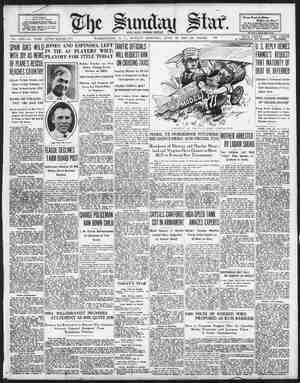Evening Star Newspaper, June 30, 1929, Page 90
You have reached the hourly page view limit. Unlock higher limit to our entire archive!
Subscribers enjoy higher page view limit, downloads, and exclusive features.
6 THE SUNDAY STAR, WASHINGTON, D. C, JUNE 30, 1929—PART 7. s P < S — Simplicity Marks American Buildings At Spain's Bxposition King Alfonso, Who Spent Moré Time in American Section Than in Any Other, Highly Pleased With United States Exhibits, Which Draw Greatest Crowds At Ibero-American Display. BY WILLIAM RUFUS SCOTT, ‘Special writer for the Star Magazine,’ mm,mm,nm.—m cans as well as Spaniards are being surprised by the United States build- ings and exhibits at the Ibzro-American 3 under way here until De- mfl.wmflmtmflmfld the Madrid government go through. out decorations, except signs over the different _ exhibits, although some bunting on the ceiling peams relieve that part of a little austerity, though without adding much artistic efTect. The one permanent building, which will be Jater as the consulate of the United is much better, yet far inferior to what y expected in an exposi- because the United States building designed upon Spanish colonial lines and the inside is comstructed upon the tradi- Spanish plan, with slight modifications, not disappoint visitors so much. =fag | §§§ ; 'y | which former Gov. . Campbell of Arizona is ostentatious exhibition. ago, when plans were Europe and Spain had impression of Uncle Sam as a type. So everything done here has been designed to give an accurate, informa- tive, helpful picture of the activities of the 'United States Government to make better living eonditions for the American people, but to do H 5 1] gl ‘American commission for the Seville Expo. it without boastfulness or comparisons of our achievements with those of Spain or any other Alfonso apparently fully perceived this of the commanding stature of the United States, and when they are understood it will be seen ‘Washington has done a good job here in the main, even if detalled criticism may be A third surprise comes to visitors in the entire absence of a commercial atmosphere in the American exhibits. No private firms or commercial activities are represented. There is no admission charge to anything, the motion picture building being free, and seats to hear A s s "ddmission counting machine at the Department of Commerce exhibit, Se- ville Exposition. A person passing between the boxes breaks a ray of light which causes the count 1o be taken. Sidney Morgan, in charge of the department’s ex- hibit, stands between the boxes. in the size of the new currency of the United States and bearing the, United States and spnmshnmmddauofmee:podtlonm passed out to appreciative visitors. The six-ton power plate printing machine brought from Washington from the bureau is operated by Samuel B. Reeder, expert plate printer, and his wife and daughter, It is always a center of attraction, partly because som-nydlbeothuexhlblum“luflu- hibits.” Explanatory remarks are made on the printing of United States stamps and bonds. KING ALFONSO may be taken as an example of the interest shown, because he looked at everything and asked many questions. The mechanism that counts visitors by their pass- ing through a ray of light arrested his atien- tion as it does all others. As Spain is en- larging its telephone facilities, the original model of Alexander Graham Bell's invention, along with the latest type telephone receiver, caused the King to call one in his entourage and chide him because he did not have in his palace such an up-to-date instrument. sition. Commissioner Gen. Thomas E. Campbell stands in the center. Photograph taken in front of the Permanent American Building. . ‘When the King saw a statuette of a Spanish jackass and learned that the Department of Agriculture, represented by Frank L. Goll, had sent it here to emphasize the fact that the American mule owes his origin to the gift of a jack to George Washington by King Charles III of Spain in 1785, he was highly interested, nor did he lose the point that America bas, by crossing the jack and the horse, produced a mule industry which annually sells to Spain between 3,000 and 5,000 of the animals. In other exhibits it is shown how the United States has taken ideas, products or ani- mals from Spain and developed them far be= yond the original types. Numbers of our hens, for instance, came from the Mediterranean countries, including Spain, such as the Minorea, and are now bigger producers than those in their native lands. The Department of Commerce exhibits draw their full quota of visitors, with the immense radio and orthophonic set, costing $30,000, sure of an interested group at all times. With all its equipment it weighs 13 tons. There is a horn on the roof of the building that broad< casts music that can be heard for a mile, while in each of the three American buildings there are loud speakers to provide music, or for making speeches and announcements. Sidney Morgan of the department must answer many questions about this exhibit. MUSIC for the motion picture theater, which is one way the United States has of informing visitors of governmental activities of & wide range, is furnished by this instrument. With it are 1,500 records, that cover not only the compositions of the United States but of all the nations represented at the exposition, and therefore make a complete appeal. Over- cost?” A private firm installed it to assist the Government in its exhibition. Having had a war with Spain a generation ago, it would not be expected that the military displays would be emphasized. However, the Navy Department sent over an exhibit under Lieut. Comdr, John M. Ashley that is drawing much attention. The newest mechanism in- in are models of the U, 8. 8. Richmond, type medium sized cruiser, and models of air-
